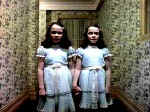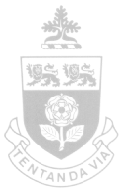Evolving Communication
Conventions
SOSC 4319 Theory and Practice
of Effective Communication
Distinctive Techniques of Kubrick
Kubrick's use of various
techniques marks patterns throughout his films. His use of the tracking
shot and the way he expresses time are two consistant techniques
found in both Eyes Wide Shut and
The Shining. An example of a tracking shot from The
Shining is when Danny is filmed riding his little tricycle
trough the hallways of the hotel. This is shot at a low angle to
show his course through the hotel from his  perspective.
The camera is behind him and moving forward with him. This type
of tracking shot also occurs in Eyes Wide Shut when the doctor
explores the house where the sex cult is held. As he walks through
the big rooms, not knowing what he might find, the camera follows
closely behind him. This creates suspense in that the viewer does
not know what he might stumble upon.
perspective.
The camera is behind him and moving forward with him. This type
of tracking shot also occurs in Eyes Wide Shut when the doctor
explores the house where the sex cult is held. As he walks through
the big rooms, not knowing what he might find, the camera follows
closely behind him. This creates suspense in that the viewer does
not know what he might stumble upon.
Thematically, Kubrick considers
time in terms of past, present and future; time is expressed using
flashbacks and alternate realities. The past is represented in The
Shining when Danny gets flashbacks of the twin's corpses. The
vision of the past only lasts a few seconds. This also occurs in
Eyes Wide Shut when the doctor gets a vision of his wife
having sex with another man. In both films the present is  communicated
through narration, which happens as the story progresses. The future
is represented in both films through the alternate reality of the
dream world. Jack experiences the future in a dream, where he sees
himself cutting Wendy and Danny into little pieces. In Eyes Wide
Shut, Kidman
dreams of a place where everyone is having sex with everyone else;
in this way, the sex cult is exposed because of this alternate reality,
which is the dream world.
communicated
through narration, which happens as the story progresses. The future
is represented in both films through the alternate reality of the
dream world. Jack experiences the future in a dream, where he sees
himself cutting Wendy and Danny into little pieces. In Eyes Wide
Shut, Kidman
dreams of a place where everyone is having sex with everyone else;
in this way, the sex cult is exposed because of this alternate reality,
which is the dream world.
Michelle Tirkalas

|
Disclaimer © 2003 - 2004 by class of SOSC 4319 at York University |